汉字的发展(英文版介绍)Chinese_character
- 格式:ppt
- 大小:7.03 MB
- 文档页数:45
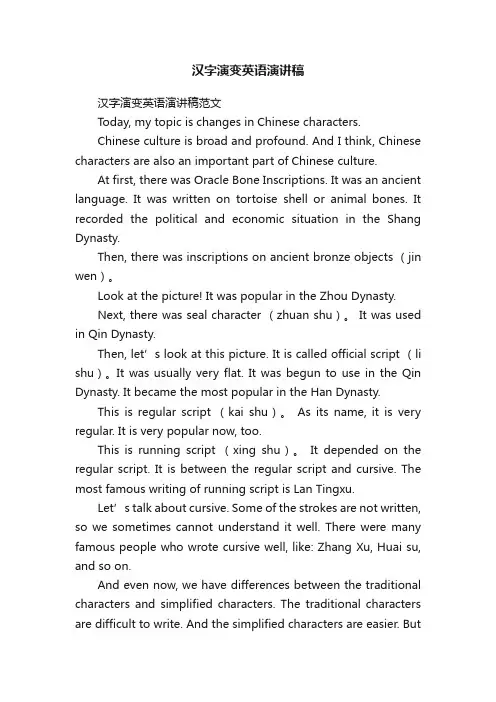
汉字演变英语演讲稿汉字演变英语演讲稿范文Today, my topic is changes in Chinese characters.Chinese culture is broad and profound. And I think, Chinese characters are also an important part of Chinese culture.At first, there was Oracle Bone Inscriptions. It was an ancient language. It was written on tortoise shell or animal bones. It recorded the political and economic situation in the Shang Dynasty.Then, there was inscriptions on ancient bronze objects (jin wen)。
Look at the picture! It was popular in the Zhou Dynasty.Next, there was seal character (zhuan shu)。
It was used in Qin Dynasty.Then, let’s look at this picture. It is called official script (li shu)。
It was usually very flat. It was begun to use in the Qin Dynasty. It became the most popular in the Han Dynasty.This is regular script (kai shu)。
As its name, it is very regular. It is very popular now, too.This is running script (xing shu)。
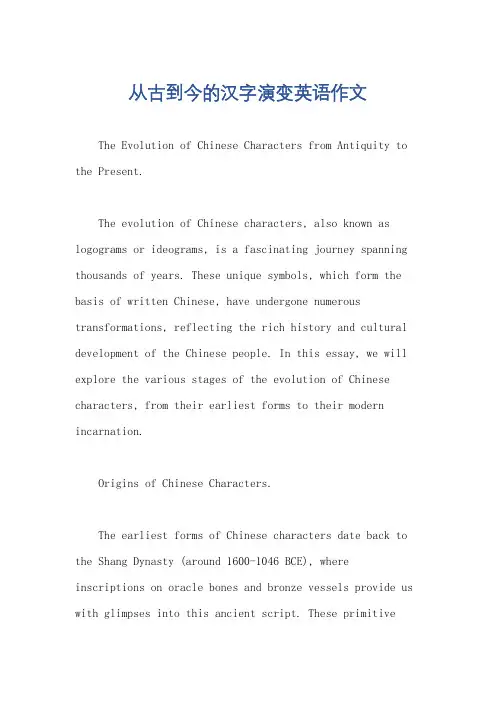
从古到今的汉字演变英语作文The Evolution of Chinese Characters from Antiquity to the Present.The evolution of Chinese characters, also known as logograms or ideograms, is a fascinating journey spanning thousands of years. These unique symbols, which form the basis of written Chinese, have undergone numerous transformations, reflecting the rich history and cultural development of the Chinese people. In this essay, we will explore the various stages of the evolution of Chinese characters, from their earliest forms to their modern incarnation.Origins of Chinese Characters.The earliest forms of Chinese characters date back to the Shang Dynasty (around 1600-1046 BCE), where inscriptions on oracle bones and bronze vessels provide us with glimpses into this ancient script. These primitivecharacters were likely based on pictographic representations of natural phenomena and objects,reflecting a close relationship between the visual and the conceptual. Gradually, as the language and society evolved, these pictographic characters were supplemented by other types of symbols, including ideographic, phonetic, and semantic-phonetic compounds.The Development of Scripts.1. Bronze Inscriptions: During the Zhou Dynasty (1046-256 BCE), Chinese characters underwent.。
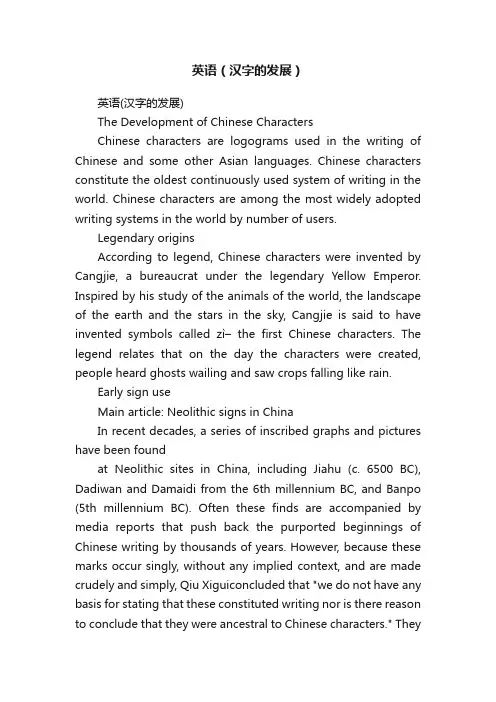
英语(汉字的发展)英语(汉字的发展)The Development of Chinese CharactersChinese characters are logograms used in the writing of Chinese and some other Asian languages. Chinese characters constitute the oldest continuously used system of writing in the world. Chinese characters are among the most widely adopted writing systems in the world by number of users.Legendary originsAccording to legend, Chinese characters were invented by Cangjie, a bureaucrat under the legendary Yellow Emperor. Inspired by his study of the animals of the world, the landscape of the earth and the stars in the sky, Cangjie is said to have invented symbols called zì–the first Chinese characters. The legend relates that on the day the characters were created, people heard ghosts wailing and saw crops falling like rain.Early sign useMain article: Neolithic signs in ChinaIn recent decades, a series of inscribed graphs and pictures have been foundat Neolithic sites in China, including Jiahu (c. 6500 BC), Dadiwan and Damaidi from the 6th millennium BC, and Banpo (5th millennium BC). Often these finds are accompanied by media reports that push back the purported beginnings of Chinese writing by thousands of years. However, because these marks occur singly, without any implied context, and are made crudely and simply, Qiu Xiguiconcluded that "we do not have any basis for stating that these constituted writing nor is there reason to conclude that they were ancestral to Chinese characters." Theydo however demonstrate a history of sign use in the Yellow River valley during the Neolithic through to the Shang period.Oracle bone scriptThe earliest confirmed evidence of the Chinese script yet discovered is the body of inscriptions carved on oracle bones from the late Shang dynasty (c. 1200–1050 BC). In 1899, pieces of these bones were being sold as "dragon bones" for medicinal。
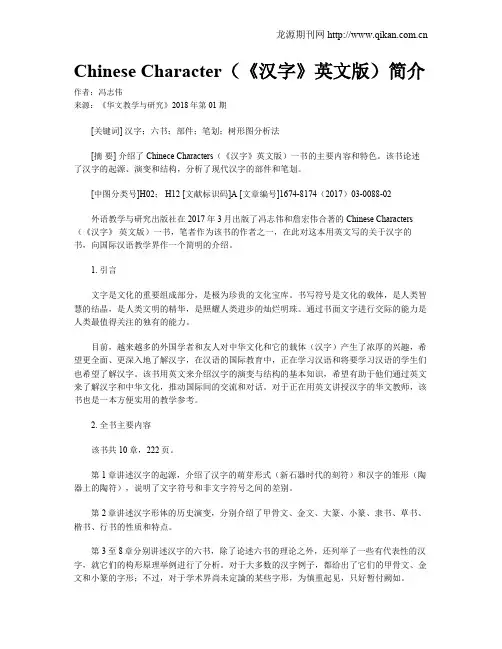
龙源期刊网 Chinese Character(《汉字》英文版)简介作者:冯志伟来源:《华文教学与研究》2018年第01期[关键词] 汉字;六书;部件;笔划;树形图分析法[摘要] 介绍了Chinece Characters(《汉字》英文版)一书的主要内容和特色。
该书论述了汉字的起源、演变和结构,分析了现代汉字的部件和笔划。
[中图分类号]H02; H12 [文献标识码]A [文章编号]1674-8174(2017)03-0088-02外语教学与研究出版社在2017年3月出版了冯志伟和詹宏伟合著的Chinese Characters (《汉字》英文版)一书,笔者作为该书的作者之一,在此对这本用英文写的关于汉字的书,向国际汉语教学界作一个简明的介绍。
1. 引言文字是文化的重要组成部分,是极为珍贵的文化宝库。
书写符号是文化的载体,是人类智慧的结晶,是人类文明的精华,是照耀人类进步的灿烂明珠。
通过书面文字进行交际的能力是人类最值得关注的独有的能力。
目前,越来越多的外国学者和友人对中华文化和它的载体(汉字)产生了浓厚的兴趣,希望更全面、更深入地了解汉字,在汉语的国际教育中,正在学习汉语和将要学习汉语的学生们也希望了解汉字。
该书用英文来介绍汉字的演变与结构的基本知识,希望有助于他们通过英文来了解汉字和中华文化,推动国际间的交流和对话。
对于正在用英文讲授汉字的华文教师,该书也是一本方便实用的教学参考。
2. 全书主要内容该书共10章,222页。
第1章讲述汉字的起源,介绍了汉字的萌芽形式(新石器时代的刻符)和汉字的雏形(陶器上的陶符),说明了文字符号和非文字符号之间的差别。
第2章讲述汉字形体的历史演变,分别介绍了甲骨文、金文、大篆、小篆、隶书、草书、楷书、行书的性质和特点。
第3至8章分别讲述汉字的六书,除了论述六书的理论之外,还列举了一些有代表性的汉字,就它们的构形原理举例进行了分析。
对于大多数的汉字例子,都给出了它们的甲骨文、金文和小篆的字形;不过,对于学术界尚未定論的某些字形,为慎重起见,只好暂付阙如。
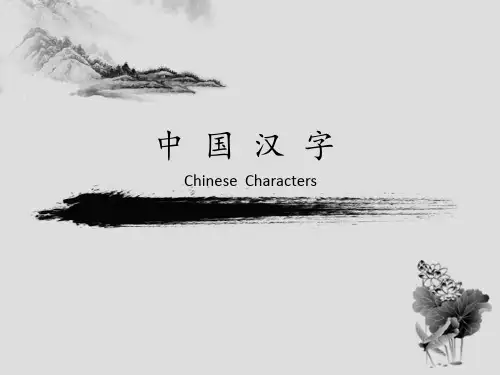
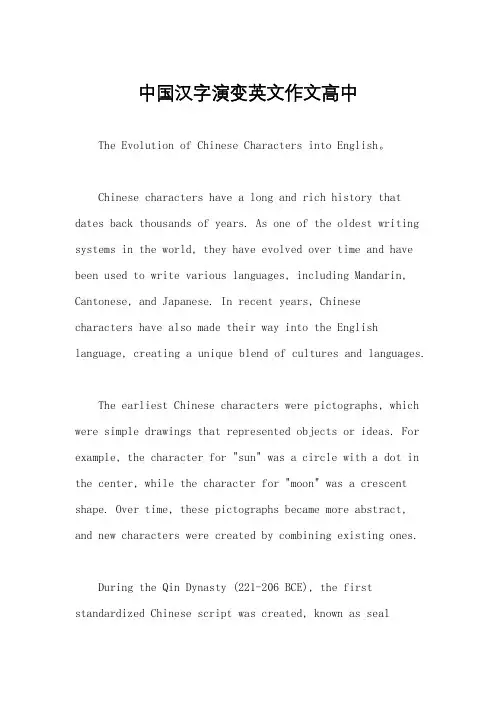
中国汉字演变英文作文高中The Evolution of Chinese Characters into English。
Chinese characters have a long and rich history that dates back thousands of years. As one of the oldest writing systems in the world, they have evolved over time and have been used to write various languages, including Mandarin, Cantonese, and Japanese. In recent years, Chinesecharacters have also made their way into the English language, creating a unique blend of cultures and languages.The earliest Chinese characters were pictographs, which were simple drawings that represented objects or ideas. For example, the character for "sun" was a circle with a dot in the center, while the character for "moon" was a crescent shape. Over time, these pictographs became more abstract, and new characters were created by combining existing ones.During the Qin Dynasty (221-206 BCE), the first standardized Chinese script was created, known as sealscript. This script was used for official documents and inscriptions on bronze vessels. It was later replaced by clerical script, which was easier to write and became the standard script for everyday use.As Chinese characters spread throughout East Asia, they were adapted to fit the languages and cultures of different regions. In Japan, for example, Chinese characters were combined with native Japanese scripts to create a writing system known as kanji. Similarly, in Korea, Chinese characters were used alongside the native Korean script, known as hangul.In recent years, Chinese characters have also madetheir way into the English language. This is largely due to the popularity of Chinese culture and the increasing number of Chinese speakers around the world. Many English wordsare now written using Chinese characters, such as "qi" (气), which is used to represent the concept of energy or life force, and "feng shui" (风水), which refers to the Chinese practice of arranging objects and spaces to promote harmony and balance.In addition, many English words are now beingtranslated into Chinese characters, creating a unique blend of cultures and languages. For example, the word "internet" is now commonly written as "互联网" in Chinese characters, while the word "hamburger" is written as "汉堡包".Overall, the evolution of Chinese characters into English is a testament to the power of language and culture to transcend borders and bring people together. As the world becomes increasingly interconnected, we can expect to see more and more examples of this unique blend of cultures and languages in the years to come.。

汉字的发展史英语作文500字The Evolution of Chinese Characters: A Historical Journey.Chinese characters, the foundation of the Chinese language, have undergone a remarkable transformation throughout history. Their development, spanning millennia, is a testament to the ingenuity and creativity of the Chinese people.Early Origins and Pictograms.The earliest known Chinese characters emerged around 1200 BCE during the Shang dynasty. These were pictographs, rudimentary symbols that directly represented objects or concepts. For instance, the character "日" (ri), meaning "sun," resembled the shape of the celestial body.Oracle Bone Inscriptions and Bronzeware Scripts.During the Zhou dynasty (1046-256 BCE), Chinese characters were inscribed on oracle bones and bronzeware vessels. These inscriptions served various purposes, from divination to record-keeping. The characters became more sophisticated, incorporating stylizations and abstract elements.The Standardization of the Han Dynasty.The Han dynasty (206 BCE-220 CE) marked a significant milestone in the development of Chinese characters. Emperor Qin Shi Huang unified the script, standardizing the written language across the empire. The resulting script, known as "lishu" (clerical script), became the basis for subsequent character forms.Evolution of Calligraphy.As the Han dynasty progressed, calligraphy emerged as a refined art form. Master calligraphers developed various styles, including "kaishu" (regular script), "xingshu" (running script), and "caoshu" (grass script). These stylesenhanced the aesthetic appeal of Chinese characters, making them both visually pleasing and expressive.The Influence of Buddhism.The introduction of Buddhism into China during the Northern and Southern dynasties (420-589 CE) had a profound impact on character development. Buddhist texts brought with them new concepts and technical terms, necessitating the creation of new characters.The Rise of Printing.The invention of printing during the Song dynasty (960-1279 CE) revolutionized the dissemination of knowledge and the spread of Chinese characters. Woodblock printing allowed for the mass production of books, making written materials more widely accessible.Simplification in the 20th Century.In the 20th century, the Chinese government undertook amajor reform of the Chinese character system. Complex traditional characters were simplified to make them easier to learn and write. This simplification, known as the "Simplified Character System," became the standard scriptin mainland China.Contemporary Evolution.In the digital age, Chinese characters continue to evolve. With the advent of computers and smartphones, electronic devices have introduced new ways of inputting and displaying characters. Additionally, the rise of social media has facilitated the creation and spread of new slang terms and informal character usage.Conclusion.The history of Chinese characters is a testament to the resilience and adaptability of the Chinese language. From humble beginnings as pictographs to the sophisticated characters used today, Chinese writing has undergone a remarkable journey that reflects the cultural andtechnological advancements of Chinese civilization. As the language continues to evolve, Chinese characters will undoubtedly remain a vital and dynamic element of Chinese expression.。
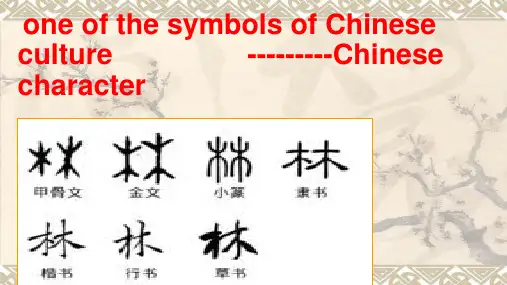
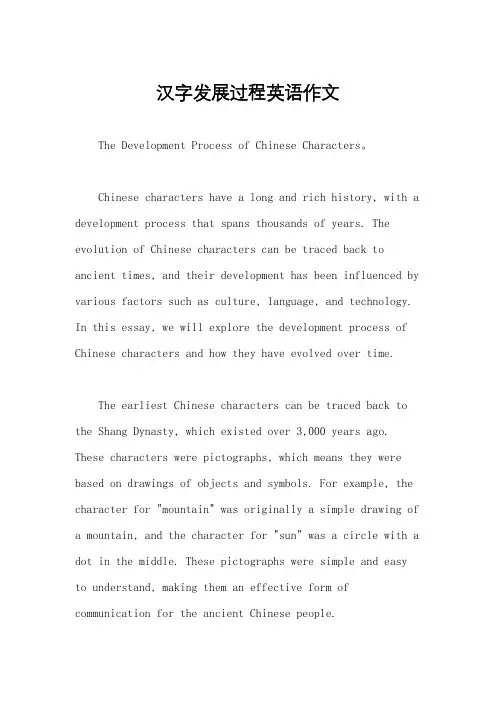
汉字发展过程英语作文The Development Process of Chinese Characters。
Chinese characters have a long and rich history, with a development process that spans thousands of years. The evolution of Chinese characters can be traced back to ancient times, and their development has been influenced by various factors such as culture, language, and technology. In this essay, we will explore the development process of Chinese characters and how they have evolved over time.The earliest Chinese characters can be traced back to the Shang Dynasty, which existed over 3,000 years ago. These characters were pictographs, which means they were based on drawings of objects and symbols. For example, the character for "mountain" was originally a simple drawing of a mountain, and the character for "sun" was a circle with a dot in the middle. These pictographs were simple and easy to understand, making them an effective form of communication for the ancient Chinese people.As time passed, the Chinese characters evolved from pictographs to ideographs. Ideographs are characters that represent ideas or concepts rather than physical objects. This shift in the structure of Chinese characters allowed for a more abstract and nuanced form of communication. For example, the character for "love" is a combination of the characters for "heart" and "friend," symbolizing the concept of affection and friendship.During the Qin and Han Dynasties, the Chinese characters underwent another significant change with the standardization of the script. This standardization was led by the first emperor of China, Qin Shi Huang, who sought to unify the writing system in order to facilitate communication and governance. The result was the creation of the small seal script, which became the standard form of writing for centuries to come.In the following dynasties, the Chinese characters continued to evolve, with the introduction of new styles of calligraphy and the development of printing technology. Thecalligraphy of the Tang Dynasty, for example, is renowned for its elegance and grace, and it had a profound influence on the development of Chinese characters. Additionally, the invention of woodblock printing during the Song Dynasty allowed for the mass production of books, which further spread the use of Chinese characters throughout China and beyond.In modern times, the Chinese characters have continued to evolve with the advent of technology. The development of computers and smartphones has led to the creation of simplified and traditional Chinese characters, as well as the adoption of Pinyin, a system for transcribing Chinese characters into the Latin alphabet. These advancements have made it easier for people to learn and use Chinese characters, and they have also facilitated the global spread of the Chinese language.In conclusion, the development process of Chinese characters is a testament to the rich history and culture of China. From their origins as pictographs to their modern-day use in technology, Chinese characters haveevolved in response to the changing needs of society. As a result, they continue to be an integral part of Chinese culture and a unique and fascinating form of writing.。
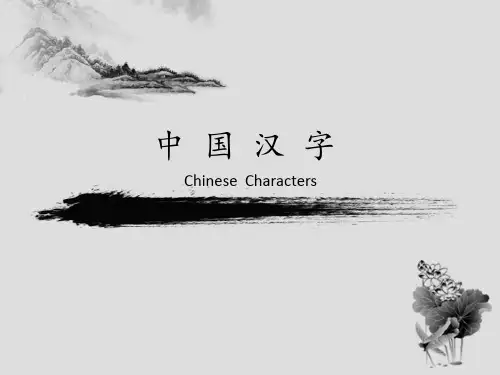
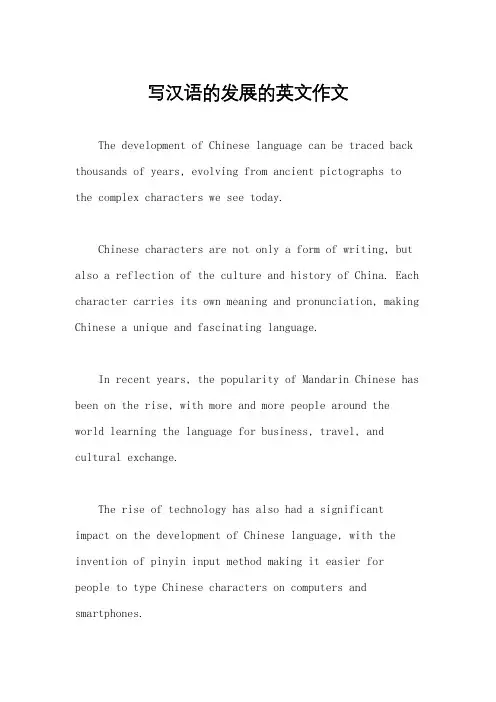
写汉语的发展的英文作文The development of Chinese language can be traced back thousands of years, evolving from ancient pictographs to the complex characters we see today.Chinese characters are not only a form of writing, but also a reflection of the culture and history of China. Each character carries its own meaning and pronunciation, making Chinese a unique and fascinating language.In recent years, the popularity of Mandarin Chinese has been on the rise, with more and more people around the world learning the language for business, travel, and cultural exchange.The rise of technology has also had a significant impact on the development of Chinese language, with the invention of pinyin input method making it easier for people to type Chinese characters on computers and smartphones.Despite the challenges of learning Chinese characters, many people are drawn to the beauty and complexity of the language, finding joy in mastering its intricacies and nuances.As China continues to play a prominent role on the global stage, the importance of Chinese language proficiency is only expected to grow, making it a valuable skill for anyone looking to succeed in the 21st century.。
Chinese Character(《汉字》英文版)简介作者:冯志伟来源:《华文教学与研究》2018年第01期[关键词] 汉字;六书;部件;笔划;树形图分析法[摘要] 介绍了Chinece Characters(《汉字》英文版)一书的主要内容和特色。
该书论述了汉字的起源、演变和结构,分析了现代汉字的部件和笔划。
[中图分类号]H02; H12 [文献标识码]A [文章编号]1674-8174(2017)03-0088-02外语教学与研究出版社在2017年3月出版了冯志伟和詹宏伟合著的Chinese Characters (《汉字》英文版)一书,笔者作为该书的作者之一,在此对这本用英文写的关于汉字的书,向国际汉语教学界作一个简明的介绍。
1. 引言文字是文化的重要组成部分,是极为珍贵的文化宝库。
书写符号是文化的载体,是人类智慧的结晶,是人类文明的精华,是照耀人类进步的灿烂明珠。
通过书面文字进行交际的能力是人类最值得关注的独有的能力。
目前,越来越多的外国学者和友人对中华文化和它的载体(汉字)产生了浓厚的兴趣,希望更全面、更深入地了解汉字,在汉语的国际教育中,正在学习汉语和将要学习汉语的学生们也希望了解汉字。
该书用英文来介绍汉字的演变与结构的基本知识,希望有助于他们通过英文来了解汉字和中华文化,推动国际间的交流和对话。
对于正在用英文讲授汉字的华文教师,该书也是一本方便实用的教学参考。
2. 全书主要内容该书共10章,222页。
第1章讲述汉字的起源,介绍了汉字的萌芽形式(新石器时代的刻符)和汉字的雏形(陶器上的陶符),说明了文字符号和非文字符号之间的差别。
第2章讲述汉字形体的历史演变,分别介绍了甲骨文、金文、大篆、小篆、隶书、草书、楷书、行书的性质和特点。
第3至8章分别讲述汉字的六书,除了论述六书的理论之外,还列举了一些有代表性的汉字,就它们的构形原理举例进行了分析。
对于大多数的汉字例子,都给出了它们的甲骨文、金文和小篆的字形;不过,对于学术界尚未定論的某些字形,为慎重起见,只好暂付阙如。
汉字发展英文作文The development of Chinese characters can be tracedback thousands of years. It is a fascinating journey that reflects the rich history and culture of China.Chinese characters are pictographic, which means they are based on pictures of objects. This makes them uniqueand visually interesting.Each Chinese character has its own meaning and pronunciation, and there are thousands of characters in the Chinese language. This makes learning Chinese characters a challenging but rewarding experience.The evolution of Chinese characters has been influenced by various factors, including changes in writing materials, calligraphy styles, and cultural exchanges with other countries.Chinese characters are not only a form of communication,but also a form of art. The beauty of Chinese calligraphy lies in the graceful strokes and the balance of the characters.In today's digital age, the use of Chinese characters has expanded beyond traditional writing. They are now used in digital communication, advertising, and design, showcasing the adaptability and versatility of the characters.The preservation and promotion of Chinese characters are important for the continuation of Chinese culture and heritage. Efforts are being made to ensure that future generations will continue to appreciate and understand the beauty and significance of Chinese characters.。
汉字的发展有关的英语作文The evolution of Chinese characters is a mesmerizing journey through time, a tapestry woven with intricate strokes and profound meanings. From the ancient oracle bones to the digital era, these characters have endured, morphing and adapting with the tides of history.In the beginning, characters were born from the strokes of brush and ink, crafted by sages and scholars seeking to capture the essence of the world around them. Each stroke carried with it layers of symbolism and tradition, a reflection of the culture that birthed it.As time marched on, the characters evolved, branching out into myriad styles and forms. Calligraphy became an art form in its own right, with masters wielding their brushes like swords, leaving behind trails of ink that danced across the page.With the advent of printing, characters took on newlife, reproduced en masse and disseminated across vast swathes of land. The written word became accessible to the masses, empowering the common people with knowledge and wisdom.But it was in the digital age that characters truly came into their own. No longer confined to paper and ink, they leaped onto screens and keyboards, transcendingphysical boundaries and connecting people across continents.Today, Chinese characters continue to evolve, shaped by the forces of globalization and technology. Emoticons and emojis add new layers of meaning, infusing the written word with a touch of whimsy and playfulness.Yet, amidst all this change, the essence of the characters remains unchanged. They are more than just symbols on a page; they are the threads that bind together the fabric of Chinese culture, weaving a story that spans thousands of years.。
汉字发展过程英语作文The development process of Chinese characters spans thousands of years and reflects the rich cultural historyof China. From its earliest forms to modern-day usage, Chinese characters have undergone significant evolution and adaptation.The origins of Chinese characters can be traced back to ancient pictographs, which were simple drawingsrepresenting objects or ideas. These early forms gradually evolved into more abstract symbols as they werestandardized and used for communication. 。
One important milestone in the development of Chinese characters was the invention of writing materials such as bamboo strips and silk in ancient times. These materials allowed for the widespread dissemination of written texts, leading to the standardization and refinement of characters.During the Qin Dynasty (221-206 BCE), Emperor Qin ShiHuang implemented a unified system of writing, which standardized the script and laid the foundation for the modern Chinese writing system. This system, known as seal script, was characterized by its square-shaped characters with uniform stroke thickness.Over time, various script styles emerged, each with its own distinct characteristics and purposes. These included clerical script, cursive script, and regular script, among others. Each script style represented different stages in the evolution of Chinese calligraphy and contributed to the diversity and richness of Chinese writing.The spread of Buddhism to China during the Han Dynasty (206 BCE – 220 CE) also had a significant impact on the development of Chinese characters. Buddhist monkstranslated sacred texts from Sanskrit into Chinese, leading to the creation of new characters to represent foreign concepts and terminology. This process, known as transcription, expanded the Chinese writing system and enriched its vocabulary.During the Tang Dynasty (618-907 CE), woodblockprinting was invented, enabling the mass production of written materials. This technological advancement contributed to the widespread literacy and the standardization of Chinese characters across different regions of China.In the modern era, the development of printing technologies, such as movable type and digital printing, has further facilitated the dissemination of Chinese characters and the standardization of written Chinese. Today, Chinese characters are used not only in China but also in other countries with significant Chinese-speaking populations, such as Taiwan, Singapore, and Malaysia.In conclusion, the development of Chinese characters is a testament to the ingenuity and creativity of the Chinese people throughout history. From its humble beginnings as pictographs to its modern-day usage in a digital age, the evolution of Chinese characters reflects the cultural, technological, and linguistic advancements of Chinese civilization.。
中国汉字发展英文作文下载温馨提示:该文档是我店铺精心编制而成,希望大家下载以后,能够帮助大家解决实际的问题。
文档下载后可定制随意修改,请根据实际需要进行相应的调整和使用,谢谢!并且,本店铺为大家提供各种各样类型的实用资料,如教育随笔、日记赏析、句子摘抄、古诗大全、经典美文、话题作文、工作总结、词语解析、文案摘录、其他资料等等,如想了解不同资料格式和写法,敬请关注!Download tips: This document is carefully compiled by theeditor. I hope that after you download them,they can help yousolve practical problems. The document can be customized andmodified after downloading,please adjust and use it according toactual needs, thank you!In addition, our shop provides you with various types ofpractical materials,such as educational essays, diaryappreciation,sentence excerpts,ancient poems,classic articles,topic composition,work summary,word parsing,copyexcerpts,other materials and so on,want to know different data formats andwriting methods,please pay attention!The development of Chinese characters can be tracedback to ancient times, when people used pictographs to represent objects and ideas. These early characters were simple and easy to understand, but as the language evolved, they became more complex and abstract.Today, Chinese characters are a unique form of writing, with each character representing a word or an idea. There are thousands of characters in the Chinese language, and each one has its own distinct shape and meaning. Learningto read and write Chinese characters can be a daunting task, but it is also a rewarding one.One of the most fascinating aspects of Chinese characters is their ability to convey meaning through their visual appearance. Unlike the letters of the English alphabet, which have no inherent meaning, Chinesecharacters are rich with symbolism and history. Each character is a work of art in itself, with a story to tell.The evolution of Chinese characters has been influenced by various factors, including changes in writing materials, cultural exchange, and technological advancements. As a result, the characters have undergone numerous changes over the centuries, but their essential form and structure have remained remarkably consistent.In recent years, the use of Chinese characters has expanded beyond traditional writing to include digital communication. With the rise of the internet and social media, Chinese characters are now being used in new and creative ways, allowing for greater expression and communication.Overall, the development of Chinese characters is a testament to the richness and complexity of the Chinese language. As the world becomes increasingly interconnected, the importance of Chinese characters will only continue to grow, making them an essential part of global communication and understanding.。